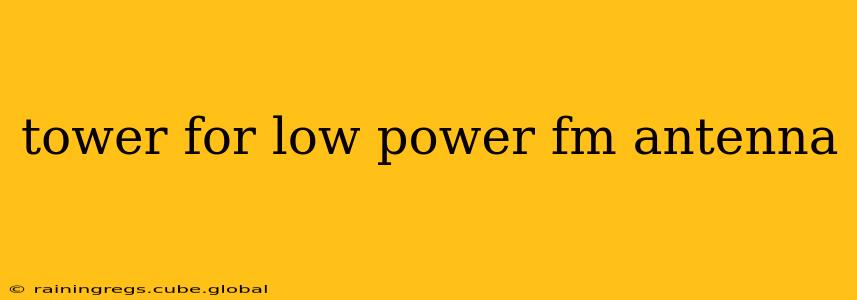Broadcasting your low power FM (LPFM) signal requires careful consideration of many factors, and one of the most crucial is the antenna tower. The right tower ensures optimal signal reach and minimizes interference, maximizing your station's potential audience. This guide delves into choosing the perfect tower for your low-power FM antenna.
What are the Different Types of Towers for LPFM Antennas?
Several tower types can support your LPFM antenna, each with its advantages and disadvantages. The best choice depends on factors like budget, location, terrain, and desired broadcast range.
-
Guyed Towers: These are the most common type for LPFM stations. They consist of a vertical tower supported by guy wires anchored to the ground. Guyed towers are relatively inexpensive and can be built to considerable heights, making them ideal for reaching a wider audience. However, they require a significant ground space for anchoring the guy wires.
-
Self-Supporting Towers: These towers stand independently without guy wires. They are typically more expensive than guyed towers but offer greater flexibility in terms of placement, as they don't require extensive ground space. Self-supporting towers are a good option for locations with limited ground area or challenging terrain.
-
Rooftop Mounts: If your broadcast range requirements are minimal, and your building permits allow it, mounting the antenna on a rooftop could be a cost-effective solution. This eliminates the need for a separate tower but restricts height and may compromise signal coverage.
How Tall Should My Tower Be for My LPFM Antenna?
The ideal height of your tower depends on several factors, including:
- Terrain: Rolling hills or mountainous terrain will require a taller tower to overcome obstacles and achieve optimal signal coverage.
- Desired Coverage Area: A larger coverage area will typically necessitate a taller tower.
- Regulatory Requirements: Your license from the Federal Communications Commission (FCC) will specify limitations on your effective radiated power (ERP) and antenna height above average terrain (HAAT). You must adhere to these regulations.
What Materials Are Commonly Used for LPFM Antenna Towers?
Common materials include:
- Steel: Steel towers are strong, durable, and relatively inexpensive. They are the most frequently used material for LPFM antenna towers.
- Aluminum: Aluminum towers offer excellent corrosion resistance, making them suitable for environments with high humidity or salt spray. However, they are generally more expensive than steel towers.
How Do I Choose the Right Tower Height for My Budget?
Tower height directly impacts cost. Taller towers are more expensive due to increased materials and construction requirements. You need to carefully balance your budget with your desired signal coverage. Consider consulting with a professional antenna engineer to determine the optimal height that provides sufficient coverage within your budget.
What are the Safety Regulations for LPFM Antenna Towers?
Safety is paramount. You must comply with all relevant safety regulations, including those set forth by the Occupational Safety and Health Administration (OSHA) and local building codes. This includes proper grounding, lightning protection, and regular tower inspections. Failing to adhere to safety regulations can result in serious consequences, including fines and legal liability.
What about Lightning Protection for my LPFM Antenna Tower?
Protecting your tower and equipment from lightning strikes is critical. This usually involves installing a lightning rod system at the top of the tower and grounding the entire structure to dissipate electrical charges. A surge protector should also be installed to protect your broadcasting equipment.
Where Can I Find More Information About LPFM Antenna Towers?
The FCC website is an excellent resource for information on LPFM licensing and technical requirements. Consulting with a professional antenna engineer is highly recommended to ensure compliance with all regulations and to optimize your broadcast signal.
This guide provides a foundational understanding of choosing the right tower for your low-power FM antenna. Remember, it's crucial to consult with professionals and adhere to all regulations to ensure a safe and successful broadcasting operation.
